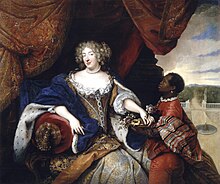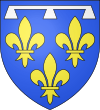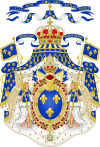| Revision as of 06:28, 16 March 2012 editFactStraight (talk | contribs)Extended confirmed users, Pending changes reviewers11,161 edits Undid revision 481993524 by 81.155.91.37 (talk)← Previous edit | Revision as of 14:05, 20 April 2012 edit undoHammyDoo (talk | contribs)690 editsm HammyDoo moved page Elizabeth Charlotte, Princess Palatine to Elisabeth Charlotte of the Palatinate, Princess Palatine: Elisabeth Charlotte of where?Next edit → |
| (No difference) | |
Revision as of 14:05, 20 April 2012
For the wife of Elector George William of Brandenburg, see Elizabeth Charlotte of the Palatinate (1597-1660). Duchess of Orléans| Elisabeth Charlotte, Princess Palatine | |
|---|---|
| Duchess of Orléans | |
 | |
| Born | (1652-05-27)27 May 1652 Heidelberg Castle, Heidelberg, Baden-Württemberg, Germany |
| Died | 8 December 1722(1722-12-08) (aged 70) Château de Saint-Cloud, Paris, France |
| Burial | Basilica of Saint Denis, France |
| Spouse | Philippe I, Duke of Orléans |
| Issue Detail | Alexandre Louis, Duke of Valois Philippe, Duke of Orléans Élisabeth Charlotte, Duchess of Lorraine |
| Father | Charles I Louis, Elector Palatine |
| Mother | Landgravine Charlotte of Hesse-Kassel |
| Religion | Calvinism then Roman Catholicism |
Elizabeth Charlotte, Princess Palatine (Template:Lang-de b. Heidelberg, 27 May 1652 – Saint-Cloud, 8 December 1722) was a German princess and the wife of Philippe I, Duke of Orléans, younger brother of Louis XIV of France. Her vast correspondence provides a detailed account of the personalities and activities at the court of her brother-in-law, Louis XIV. She and her husband, the Duke of Orléans, were the founders of the modern House of Orléans - their only surviving son, Philippe II, Duke of Orléans, being the Regent of France during the minority of Louis XV of France. She was also an ancestress of Emperor Francis I and King Louis Philippe I and thus many royal houses in Europe such as the Spanish, Italian, Bulgarian, Austrian, Tuscan, and Neapolitan royal families are descended from her.
Biography
Princess Elisabeth was born on 27 May 1652 in the Heidelberg Castle, to Charles I Louis, Elector Palatine of the Simmern branch of the House of Wittelsbach, and Landgravine Charlotte of Hesse-Kassel.
In childhood she became known as Liselotte - a mixture of her names. Her parents were in an unhappy dynastic marriage and in 1653 her father began an affair with Marie Luise von Degenfeld, one of his wife's attendants. He purported to marry her without benefit of a judicial divorce, and claimed to have done so to legitimise the bastard children. Their daughter was five years old when she was sent to live with her father's sister, Sophia, wife of Ernest Augustus, Elector of Hanover.
She always remembered her time with her aunt as the happiest of her life, although she became close enough to her younger half-sisters to correspond with them at least weekly after she married. In 1663, Liselotte had to move back to Heidelberg where she lived with her stepmother, fifteen half-siblings, and brother, the future Charles II, Elector Palatine.
She had purportedly desired to marry her cousin William III of Orange, who would later become King of England, though her family believed that sacrifices needed to be made in order to make a more beneficial marriage with the recently widowed brother of the King of France, formerly married to her father's first cousin, Princess Henrietta Anne of England.

Marriage
On 16 November 1671, she was married by proxy at Metz. By prearrangement, after leaving her father's realm but prior to arriving in France, she formally converted to Roman Catholicism. At the French court, her husband Philippe was known by the traditional honorific of Monsieur. As his wife, Elizabeth Charlotte assumed the style of Madame.
Elizabeth Charlotte was very close to her two stepdaughters Marie Louise and Anne Marie. When Marie Louise left France to marry Charles II of Spain in 1679, Liselotte accompanied her to Orléans.
The homosexual proclivities of her husband were well known at court. Elisabeth Charlotte even confided that he needed "rosaries and holy medals draped in the appropriate places to perform the necessary act" with her.
Elizabeth Charlotte objected to money spent on his favourites and the exercise of their influence with him to enrich themselves. She said on the subject:
I could put up with it if Monsieur only squandered his money in gaming, but sometimes he gives away as much as 100,000 francs at one swoop, and all the economies fall upon me and the children. That is not at all pleasant, besides putting me in a position where, as God is my witness, we would have to live entirely on the King's charity, which is a miserable thing.
Elizabeth Charlotte had apartments at Versailles, use of the Palais-Royal in Paris, and her favourite residence, the beautiful Château de Saint-Cloud on the outskirts of Paris, which was the couple's main residence when not at the Palace of Versailles. Liselotte also had an apartment at the King's private residence, the Château de Marly. In her dowager years she would stay at the Grand Trianon built by her brother in law.
The marriage at first proved to be happy, with the birth of two male heirs. After the death of the couple's first son, the Duke of Valois, she experienced depression and worried about her third pregnancy (with Élisabeth Charlotte d'Orléans). After this birth, the relationship between husband and wife was never as close as it had been. The couple had three children;
After the birth of their daughter Élisabeth Charlotte, the couple mutually agreed to cease conjugal relations. Philippe turned to his minions, and Elizabeth Charlotte to writing.
Her letters to her aunt Sophia and others created not only a vivid picture of life during the reign of Louis XIV, but also of the Regency era of her son, Philippe. They reflect her alienation from her husband and other family members, as well as her warm relations with the king, and with her son, daughter and her two stepdaughters.
Court Life
As the king's only brother and sister-in-law, the couple were expected to be in usual attendance at court, where her husband's rank as a fils de France ensured her precedence before all save the queen, and the wives of the king's son and grandsons — and his current maîtresse-en-titre. This last position rankled her, and she disliked the king's illegitimate children, especially Louis-Auguste, Duke of Maine.
Madame de Montespan's youngest daughter, Françoise Marie de Bourbon, would eventually marry her son. No inducements ever reconciled Elizabeth Charlotte to the marriage. When she discovered that her son had agreed to it at the king's insistence, she slapped his face in front of the whole court, and turned her back on the king as he greeted her with a bow. Later, writing on the subject she put:
If, by shedding my own blood, I could have prevented my son's marriage, I would willingly have done so; but since the thing was done, I have had no other wish than to preserve harmony
After the king transferred his affections from La Montespan to La Maintenon, Elizabeth Charlotte became obsessively resentful toward and suspicious of the latter. In her correspondence, Elisabeth Charlotte refers to her as the "King's old drab", the "old witch", and the "old whore".
In addition to letters to her aunt Sophia and her morganatic half-sisters the Raugravines, she also corresponded with the former's courtier Gottfried Leibniz, although they never met. After he died, she insisted that the Académie des Sciences, of which he had been a member, honour his passing. The resulting eulogy to Leibniz, by Fontenelle, was the only one ever delivered anywhere.
When the Simmern branch of the Wittelsbach dynasty became extinct in the male line with the death of her brother Karl II in 1685, Louis XIV sent troops to claim the Palatinate in his sister-in-law's name, launching the War of the Grand Alliance (1688–1697).
On 9 June 1701, her husband of just under sixty years died of a stroke at the château de Saint-Cloud. Earlier, he had a heated argument with his brother at the Château de Marly about the conduct of his son — who was also the king's son-in-law.
After her husband's death, Elizabeth Charlotte feared that the king would send her to a convent, as stipulated in her marriage contract. Instead she was confronted with secretly-made excerpts of her all-too-candid letters to correspondents abroad. She was warned to change her attitude toward Madame de Maintenon.

She remained welcome at court. She was allowed to keep her apartments at all the royal residences and retained her rank. From her husband, she inherited 40,000 livres a year. Louis XIV added 250,000 livres, and her son promised her another 200,000. Some time after Philippe's death, she wrote:
If those who are in the next world could know what was happening in this one, I think His Grace, the late Monsieur, would be most pleased with me, for I have gone through his boxes to find all the letters written to him by his boyfriends and have burnt them unread, so that they will not fall into other people's hands...then...I receive great comfort from the King, otherwise I could not endure my position. When the King speaks about Monsieur he is quite moved
In 1715, Louis XIV died aged seventy-seven at the Palace of Versailles. In his will, he divided the regnal prerogatives among relatives and courtiers, allocating to his legitimised son, the Duke of Maine, guardianship of the new king, Louis XV, who was five years old. The Parlement of Paris overturned the will's provisions at the request of Elizabeth Charlotte's son, who thus became regent.
In her memoirs, Elizabeth Charlotte describes the new era of the Regency. Although no longer outranked by any woman at court and freed from the imagined persecutions of Madame de Maintenon, she did not cease daily complaints to her correspondents about the antics of what she regarded as an increasingly decadent court, about which she wrote:
I believe that the histories that will be written about this court after we are gone will be better and more entertaining than any novel, and I am afraid that those who come after us will not be able to believe them and think they are just fairy tales.
Elizabeth Charlotte died at the age of seventy on 8 December 1722, at the château de Saint-Cloud.
Her descendants by her son form the House of Orléans, which came to the French throne in the person of Louis-Philippe in 1830. Through her daughter, she was ancestress of the House of Habsburg-Lorraine, and the great-grandmother of Marie Antoinette.
Issue
| Name | Portrait | Lifespan | Notes | |
|---|---|---|---|---|
| Alexandre Louis d'Orléans Duke of Valois |

|
2 July 1673 – 16 March 1676 |
Born at the Château de Saint-Cloud and died at the Palais-Royal before his third birthday, his death being attributed to the bloodletting by the Orléans family's doctors; last person to carry the title Duke of Valois; | |
| Philippe Charles d'Orléans Duke of Orléans |

|
2 August 1674 - 2 December 1723 |
Born at the Château de Saint-Cloud he was titled the Duke of Chartres from birth becoming Duke of Orléans in 1701; Married his first cousin Françoise Marie de Bourbon and had issue; died at the Palace of Versailles; Regent of France and Navarre during the minority of Louis XV of France - the era was known as la Régence; | |
| Élisabeth Charlotte d'Orléans Duchess of Lorraine and Bar Princess of Commercy |

|
13 September 1676 – 23 December 1744 |
Born at the Château de Saint-Cloud and married Leopold de Lorraine, Duke of Lorraine in 1698 and had issue; became the Sovereign Princess of Commercy 1737; she died at Commercy; known as Mademoiselle de Chartres; |
Nature and Appearance
She was earthy, even vulgar at times, quoting folksy sayings such as "The snow falls as easily on a cowpat as it does a rose petal." She spoke with a noticeable German accent and disliked dancing, which put her at odds with the French fashion. Compared to her predecessor, Henrietta Anne Stuart, who was pretty and graceful, Elisabeth Charlotte was stolid, mannish and Amazonian. She possessed the stamina to hunt all day, refusing to wear the mask that Frenchwomen were accustomed to use to protect their skin while watching their men hunt. Her face developed a ruddy and weather-beaten look.
She walked too rapidly for most courtiers to keep up, save the king. She had a "no-nonsense" attitude, and was not given to gallantry, but lacked the prudery to prevent her ladies-in-waiting from flirting with courtiers or royalty. Her hearty appetite caused her to gain weight as the years went by, and when describing herself she once commented that she would be as good to eat as a roasted suckling pig. Raised a Protestant, she was not fond of lengthy Latin masses.
She remained virtuous and at times outraged by the open infidelity practiced by the aristocracy. Her views were frequently the opposite of those prevalent at the French court.
She is known by different names and styles in different languages with:
- Variations of her given names, such as Charlotte Elisabeth, Elisabeth Charlotte and Liselotte von der Pfalz
- Variations of her titles and territorial designations, such as Electoral Princess, Princess Palatine, of the Palatinate, of the Rhine, etc. (also in respective forms in French and German)
At any rate, the dynastic titles she was entitled to were Countess Palatine of the Rhine and Duchess of Bavaria.
Ancestry
Titles and Styles
- 27 May 1652 – 16 November 1671 Her Serene Highness Elizabeth Charlotte, Countess Palatine of Simmern;
- 16 November 1671 – 9 June 1701 Her Royal Highness the Duchess of Orléans;
- Madame was her general style of address and reference;
- 9 June 1701 – 8 December 1722 Her Royal Highness the Dowager Duchess of Orléans.
Notes
- Fraser, Antonia, Love and Louis XIV, Anchor Books, 2006, p. 134.
- ^ ib. Fraser, p. 137.
- ib. Fraser, p. 140.
- Crompton, Louis, Homosexuality and Civilization Belknap, Cambridge, MA, 2003, p. 348.
- From translated memoirs of the duchesse d'Orléans by Elisabeth Charlotte, duchesse d'Orléans:
- ib. Fraser, p 140.
- Memoirs of the duchesse d'Orléans
- All from
- Nancy Nichols Barker: Brother to the Sun King: Philippe, Duke of Orleans, The Johns Hopkins University Press, 1998..
- ^ From translated memoirs
- Secret memoirs of the court of Louis xiv, and of the regency; extracted from the German correspondence of the Duchess of Orleans, 1824
- van de Pas, Leo. "Alexandre Louis d'Orléans, Duke of Valois". Genealogics .org. Retrieved 2009-12-22.
- .ib. Fraser, p.
Further reading
- Life and letters of Charlotte Elizabeth, Princess Palatine and mother of Philipp d'Orléans, régent de France 1652 - 1722, compiled, translated, and gathered from various published and unpublished, Chapman & Hall, London, 1889.
- A woman's life in the court of the Sun King : letters of Liselotte von der Pfalz, 1652–1722, Elisabeth Charlotte, Duchesse d'Orléans, translated by Elborg Forster, Johns Hopkins University Press, 1984.
See also
| Princesses of France by marriage | ||
|---|---|---|
| 1st generation |
|  |
| 2nd generation | ||
| 3rd generation | ||
| 4th generation | ||
| 5th generation | ||
| 6th generation |
| |
| 7th generation | ||
| 8th generation | ||
| 9th generation | ||
| 10th generation | ||
| *also a princess of France in her own right | ||
| Duchesses of Orléans | |
|---|---|
|
- 1652 births
- 1722 deaths
- German letter writers
- Converts to Roman Catholicism from Calvinism
- Duchesses of Montpensier
- French nobility
- 18th-century German people
- 17th-century German people
- People of the Regency of Philippe d'Orléans
- People of the Ancien Régime
- French royalty
- French memoirists
- French princesses
- French duchesses
- House of Orléans
- House of Palatinate-Simmern
- People from Heidelberg
- Duchesses of Orléans
- Smallpox survivors
- Burials at the Basilica of St Denis